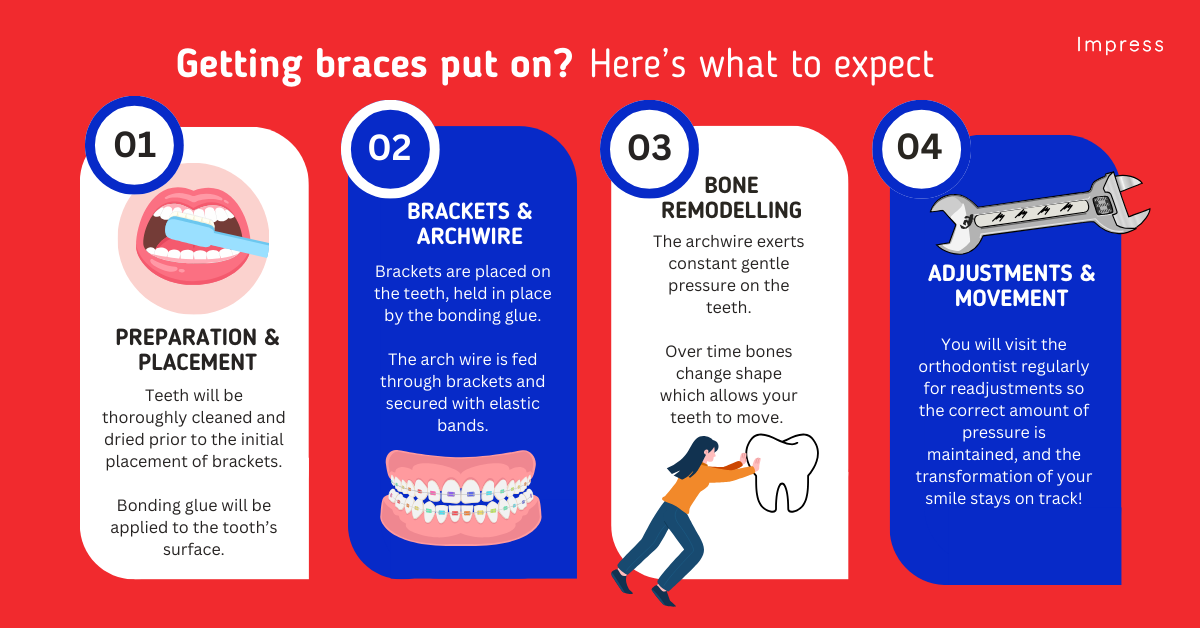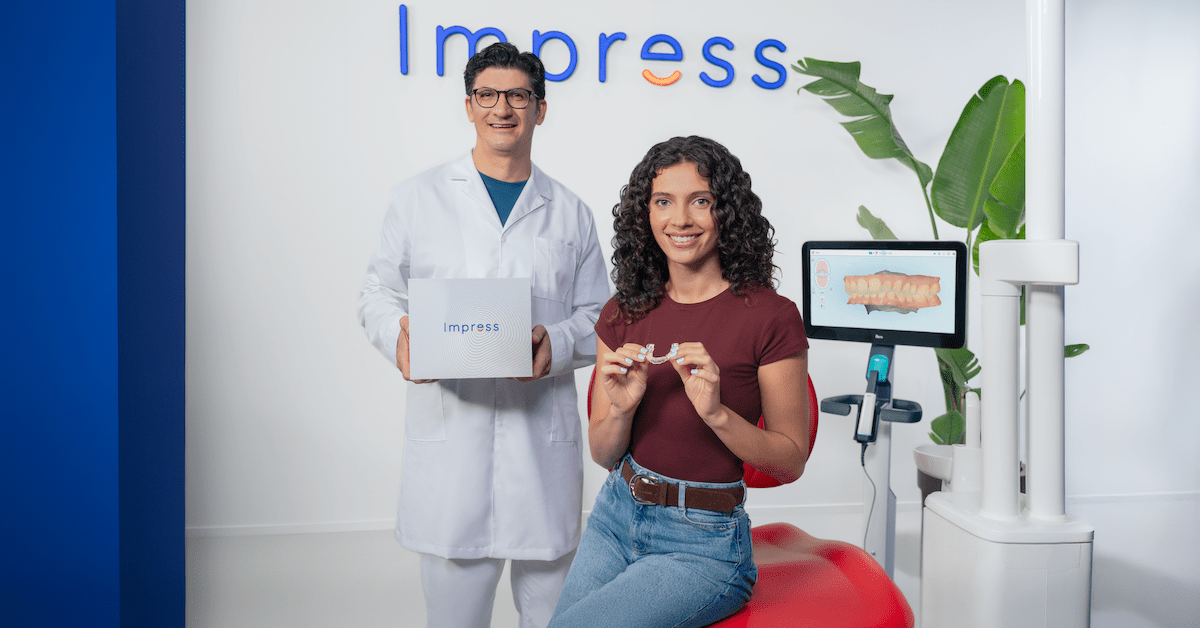How braces are put on: Procedure, steps and price
So you’re thinking about getting braces put on. You’re probably wondering, how do they put braces on? What is the process step by step? Does it hurt?
Braces have been the most popular type of orthodontic treatment to correct alignment and bite problems for years. What used to be a complex and majorly inconvenient process a while back, is now easier than ever, with options such as sapphire, ceramic and self ligating braces. Orthodontists can also put braces on with greater precision than before.
In this article we’ll go over how braces are put on, what the different techniques consist of and what the step by step process is to get braces.

How braces are put on: Techniques and steps for their placement
Wondering how braces get put on? Although there are several different types of orthodontics, there are mainly two techniques when it comes to braces being put on: a method called "direct" and another known as "indirect". Let’s take a look at the process of each of these procedures, step by step.
Direct bonding of orthodontic brackets
Direct bonding of orthodontic brackets is the original process and the most used to date when it comes to getting braces put on. In this method, the orthodontist bonds each bracket directly on the patient's teeth. This is the step by step process of getting braces put on using the direct bonding method:
- The orthodontist prepares and cleans the surface of each tooth.
- They then apply a special adhesive to the teeth for direct bonding of the orthodontic brackets.
- Then a compound is applied to each bracket.
- Then the brackets are installed one by one, using a positioner to place them in the center of each tooth.
- Once the braces are finished being put on, they remove the remaining adhesive.
- A metal arch in then used to connect all the brackets together.
- After each bracket is attached to the archwire with rubber bands (except in the case of self-ligating brackets), the procedure is finished!
Although direct bonding of the orthodontic brackets has been the most used technique, the process has some disadvantages. On the one hand, when looking at how long it takes to put braces on using this method compared to the other, it takes longer and is therefore more uncomfortable for the patient.
This also makes putting on the brackets more work for the orthodontist, who has to place each piece manually calculating the exact position on each tooth, without having an outside perspective of the teeth. So, how do they put braces on without these drawbacks? Indirect bonding.

Indirect braces bonding
The indirect bonding technique for braces was originally created for lingual appliances. It is easier than putting the braces directly, takes less time and allows the orthodontist to work more precisely without contact with the patient's saliva, tongue or inside of the cheek. Indirect braces bonding is done as follows:
- The orthodontist takes measurements of the teeth and makes a plaster cast.
- Place all brackets accurately in the mold.
- Next, they make clear splints to transfer the brackets from the mold to the teeth.
- They prepare the patient's teeth (cleaning, polishing, drying and bonding).
- Then they put an adhesive on the braces that are still in the splints.
- They place braces on teeth.
- Once the braces are place, they have to remove the transfer splints.
- They then clean up adhesive residue.
- Then finally, the metal arch is placed, along with the elastics to fix the device (except in self-ligating brackets).
Thanks to advances in orthodontics, indirect digital bonding for braces is also possible. This technique offers even more precision and allows you to prepare the placement of each bracket in a 3D software. They are then placed in the splint that will be used for the transfer.
Are all types of braces put on the same way?
It’s important to note that just as there are different types of fixed orthodontic appliances, there are also several ways to place braces and the procedure and steps may vary, which may also affect how long it takes to put the braces on.
On the one hand, we have traditional metal braces and those known as transparent or aesthetic braces, which can be made of ceramic, sapphire or other similar materials. All of these braces are put on in a similar way and can be placed following either of the techniques described above.
On the other hand, there are lingual braces that are generally placed following the indirect bracket bonding technique. As the name suggests, lingual braces are placed on the lingual (back) side of the teeth. For these, the specialist will have to work in a somewhat smaller space that is difficult to access, so the use of indirect bracket bonding helps in the process.
Finally, we have the self-ligating braces. These are generally placed in one big piece, since the arch passes through the interior of each of the brackets and they are all connected from the start. These are the only braces that don’t quite follow the direct or indirect bracket bonding methods.

Does it hurt to get braces put on?
For a lot of people, the most important question is “does it hurt to get braces put on?” The process of getting braces put on is painless. However, even though it doesn’t hurt to actually put the braces on, some discomfort or even pain may occur after they have been placed.
This pain may be caused by the device rubbing against the inside of the cheek and gums and it can be relieved with orthodontic wax. There may also be discomfort due to the pressure the braces apply on the teeth. Even though it might be bothersome, there’s no need to worry. This discomfort means that they’re doing their job and your teeth are straightening.
How long does it take to put braces on?
How long it takes to put on the braces depends on the technique used. Direct bracket placement requires more time for the patient. At least 30 minutes per arc is needed. Then there is the preparing the teeth, placing the metal arch and the elastics, so it all adds up to just over an hour.
Orthodontists often prefer to put on braces in two stages, one arch after another, in two separate appointments. This is less stressful for the patient and gives them time to get used to the new sensation.
And, how long does it take to put the braces on indirectly? These are easier to put on and can be placed on each arch in just 15 minutes. For a complete placement of both arches, plus all the preparation, approximately 1 hour is needed.
How much does it cost to put braces on your teeth?
As for how much it costs to put braces on your teeth, it’s important to note that generally the price to put on braces is usually included in the total cost of the treatment when the budget is drawn up. In the UK, the price varies depending on the type of device you choose and many other factors. If you want to know approximately how much it costs to get braces put on, you should read our article on the price of braces in the UK.

Impress aligners: orthodontic devices that are placed in less than a minute
If you are looking for an alternative to braces that is comfortable, hygienic and convenient, you’ve come to the right place. Impress clear aligners can help you correct your teeth aesthetically and discreetly. Also, if you are looking for speed, Impress aligners are the way to go. You can put on the aligners yourself in less than a minute.
The splints are made to measure from a digital impression made during the initial consultation. Once they’re ready, you can have them sent to your home along with a complete kit that includes all the accessories you’ll need until the end of your treatment.
Some patients require attachments or buttons to be placed before starting treatment. If that’s your case, our orthodontists will be in charge of placing them quickly, precisely and safely. They put on using templates that fit perfectly in the mouth of each patient that are also made from the original digital impression.
Interested in learning more about Impress treatments? We’re here to answer all your questions. You can contact at +44 20 3808 1072 or WhatsApp, or by completing a simple online form. We can’t wait to see you smile!
Frequently asked questions about getting braces put on
What are the steps for getting braces?
The steps for getting braces can vary, but usually, before you get them, you'll have one or two consultations. The first appointment is an initial consultation, where they will review the state of your mouth and perform a scan or take pictures. This will be useful to establish what type of treatment is necessary and to estimate both its duration and its cost. The second appointment usually includes an orthodontic evaluation based on the X-rays they’ll take that appointment. Sometimes X-rays can be done during the first consultation, thus avoiding extra visits.
What foods can you eat when your braces are first put on?
When you very first get your braces put on, there are some foods you are going to want to eat. If your teeth are sore you’ll want to avoid anything hard or crunchy like apples or crisps. You should also know that eating sticky foods when you get braces is not the best idea. Instead, the ideal is to opt for soft foods in order to preserve the devices as much as possible and avoid discomfort.
Who puts braces on your teeth?
The doctor who puts the braces on your teeth is an orthodontist. They are the only type of specialist who can do it. An orthodontist is first trained in dentistry and then specializes in orthodontics.
At what age can you get braces put on?
The typical age for getting braces put on is simply the age of "oral maturity." In other words, around the age of 11 or 12 is typically when you can get braces. However, before this age, children can undergo interceptive orthodontics. As for how old you can be, there is no age limit for using orthodontics. Braces can be put on at any age.




